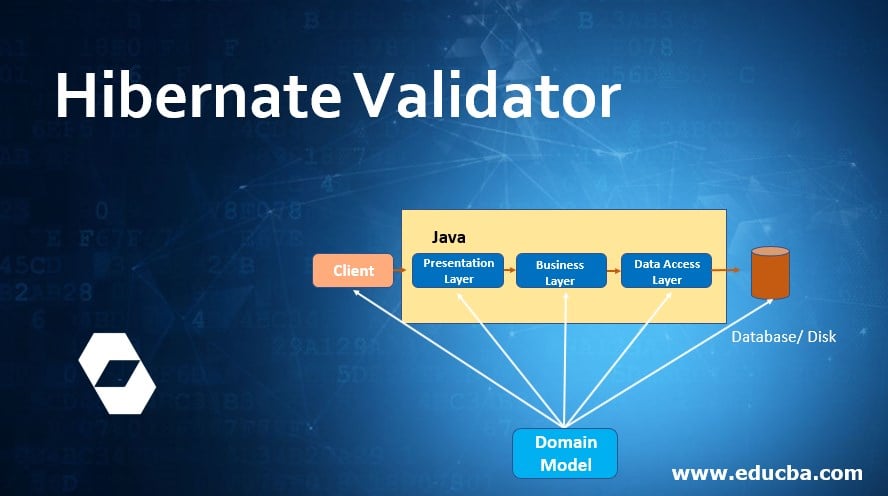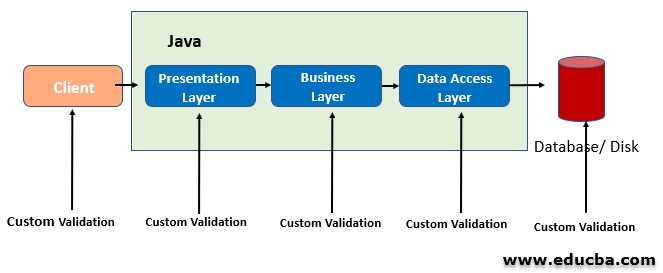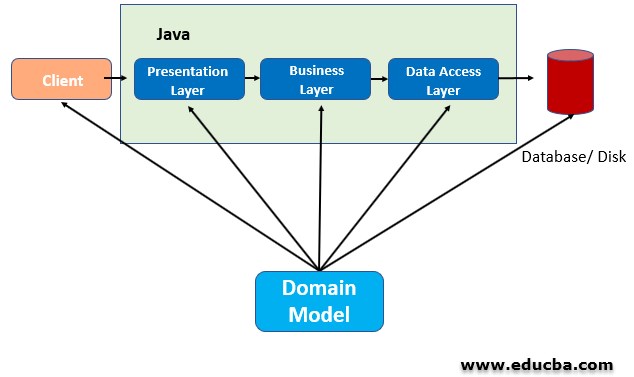Updated March 31, 2023

Introduction to Hibernate Validator
A common task for all the application layers will be validating the data from the presentation to persistence layer. The logic implementation in validation of often the same with regard to each layer is often error-prone and time consuming. To avoid such, and also the duplication of such models, a bundle of validation logic is developed by the developers into the cluttering domain classes, domain model with code validation which is metadata about the class itself. Method validation and definition of a metadata model and API for an entity is denied by Jakarta Bean Validation 2.0.
How does Hibernate Validator Work?
There is an ability to extend and override the metadata with the use of XML. API isn’t tied to a specific application tier nor a model programming. It is available for application developers of rich client swing as well as server-side application programs.
A reference implementation of Jakarta Bean Validation is Hibernate Validation. The version of Java 8 or further is required for Jakarta Bean Validation and Hibernate Validator 6.
Starting off with the reference implementation of Jakarta Bean validation. For a quick start we need:
- Apache Maven
- JDK 8
- internet connection
Now, let’s get into project setup add the following dependency to your pom.XML in order to use Hibernate validator within a Maven project.
<dependency>
<groupId>org.hibernate.validator<groupId>
<artifactId>hibernate-validator</artifactId>
<version>6.1.2.Final</version>
</dependency>
Dependency to Jakarta Bean validation API is transitively pulled. When your application runs on JBoss AS, such as a Java EE container., implementation is already provided by the container.
An implementation of Jakarta Expression Language is required for Hibernate Validator for evaluation of dynamic expression in violation constraint messages. When the application is run on JBoss AS, a Java EE container, a provision of EL implementation is already there by the container. As a dependency to your POM file you can add a java SE environment. For your referencean instance is provided below which you can add the following dependancy where you can use Jakarta EL. , the below shows a dependency to use Jakarta EL.
<dependency>
<groupId>org.glassfish<groupId>
<artifactId>Jakarta.el</artifactId>
<version>3.0.3</version>
</dependency>
Addition of dependency is usually not required for application run on Java EE application server.
1. Security Manager Run
Running with a security manager is supported by Hibernate Validator. one must assign permissions to the base code of Hibernate Validator, API of the Jakarta Bean Validation, JBoss logging and classmate, also the calling of the code base of Jakarta Bean Validation. The below explains how it is done via policy file as done and implemented by Java default policy.
Example for usage of Hibernate Validator for policy file with a security manager:
grant codeBase "file:path/to/hibernate-validator-6.1.2.Final.jar"{
permission java.lang.reflect.ReflactPermission "suppressAccessChecks";
permission java.lang.reflect.RuntimePermission "accessDeclaredMembers";
permission java.lang.reflect.RuntimePermission "setContextClassLoader";
permission org.hibernate.validator.HibernateValidatorPermission "accessPrivateMembers";
//Only needed when working with XML description(validation.xml or XML constraint mappings)
permission java.util.PropertyPermission "mapAnyUriToUri", "read";
};
grant codeBase "file:path/to/jakarta.validation-api-2.0.2.jar"{
permission java.io.FilePermission "path/to/hibernate-validator-6.1.2.Final.jar", "read";
};
grant codeBase "file:path/to/jboss-logging-3.3.2.jar"{
permission java.java.PropertyPermission "org.jboss.logging.provider", "read";
permission java.java.PropertyPermission "org.jboss.logging.locale", "read";
};
grant codeBase "file:path/to/classmate-1.3.4.jar"{
permission java.lang.RuntimePermission "accessDeclaredMembers";
};
grant codeBase "file:path/to/validate-caller-x.y.z.jar"{
permission org.hibernate.validtor.HibernateValidatorPermission "accessPrivateMembers";
};
2. Update the Hibernate Validator in WildFly
The application server of WildFly contains Hibernate Validator out of the box. To update the modules of server for API Jakarta Bean Validation, and Hibernate Validator to greatest and latest, the mechanism called path of idFly can be used.
Patch file can be downloaded from Maven Central or SourceForge using the dependency given below :
WildFly Maven dependency, final patch file :
<dependency>
<groupId>org.hibernate.validator<groupId>
<artifactId>hibernate-validator-modules</artifactId>
<version>6.1.2.Final</version>
<classifier>wildfly-18.0.0.Final-patch</classifier>
<type>zip</type>
</dependency>3. Run on Java 9
As the Hibernate Validtor version – 6.1.2 which is Final supports for Java 9, and the module of JavaPlatform (JPMS) is experimental. Hibernate Validators are usable as modules of automatic when there is no JPMS module descriptors provision.
4. Validating the Constraints
Using a Validator Instance is done to perform a validation of the constraints.
package org.hibernate.validator.referenceguide.chapter01;
import java.util.Set;
import javax.validation.ConstraintViolation;
import javax.validation.Validation;
import javax.validation.Validator;
import javax.validation.ValidatorFactory;
import org.junit.BeforeClass;
import org.junit.Test;
import static org.junit.Assert.assertEquals;
public class TestCar {
private static Validator validator;
@BeforeClass
public static void setUpValidator() {
ValidatorFactory factory = Validation.buildDefaultValidatorFactory();
validator = factory.getValidator();
}
@Test
public void manufacturerIsNull() {
Carname car = new Car( null, "AB-CD-123", 4 );
Set<ConstraintViolation<Car>> constraintViolations =
validator.validate( car );
assertEquals( 1, constraintViolations.size() );
assertEquals( "should not be null", constraintViolations.iterator().next().getMssage() );
}
@Test
public void licensePlateTooShort() {
Carname car = new Car( "Maruthi", "D", 4 );
Set<ConstraintViolation<Car>> constraintViolations =
validator.validate( car );
assertEquals( 1, constraintViolations.size() );
assertEquals(
"size must be between 5 and 14",
constraintViolations.iterator().next().getMessage()
);
}
@Test
public void seatCountTooLow() {
Car car = new Car( "Maruthi", "AB-CB-123", 1 );
Set<ConstraintViolation<Car>> constraintViolations =
validator.validate( car );
assertEquals( 1, constraintViolations.size() );
assertEquals(
"must be greater > or = to 2",
constraintViolations.iterator().next().getMessage()
);
}
@Test
public void carIsValid() {
Carname car = new Car( "Maruthi", "AB-CD-123", 2 );
Set<ConstraintViolation<Car>> constraintViolations =
validator.validate( car );
assertEquals( 0, constraintViolations.size() );}
}Conclusion
Hibernate Validator is a reference implementation of 2.0 Jakarta Bean Validation, Jakarta Bean Validation, which is an API and a Metadata model for JavaBean and also the method validation. Annotations are the default metadata source and have the ability to extend and override the dam through the validation of XML descriptors.
Recommended Articles
This is a guide to Hibernate Validator. Here we also discuss the Introduction and how does hibernate validator works along with different examples and its code implementation. You may also have a look at the following articles to learn more –



